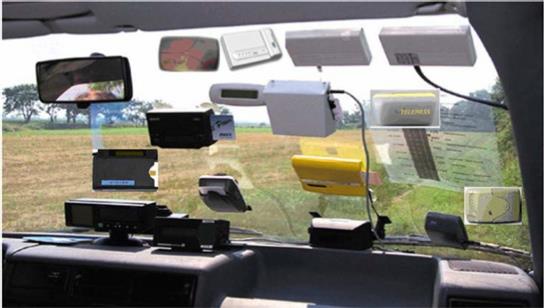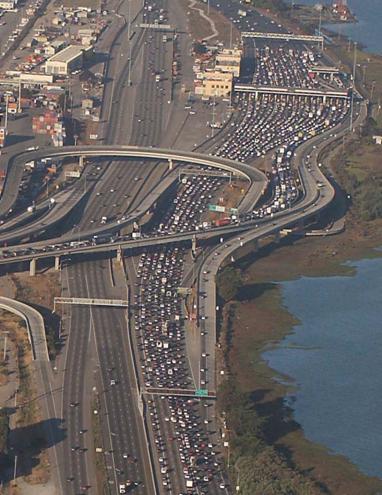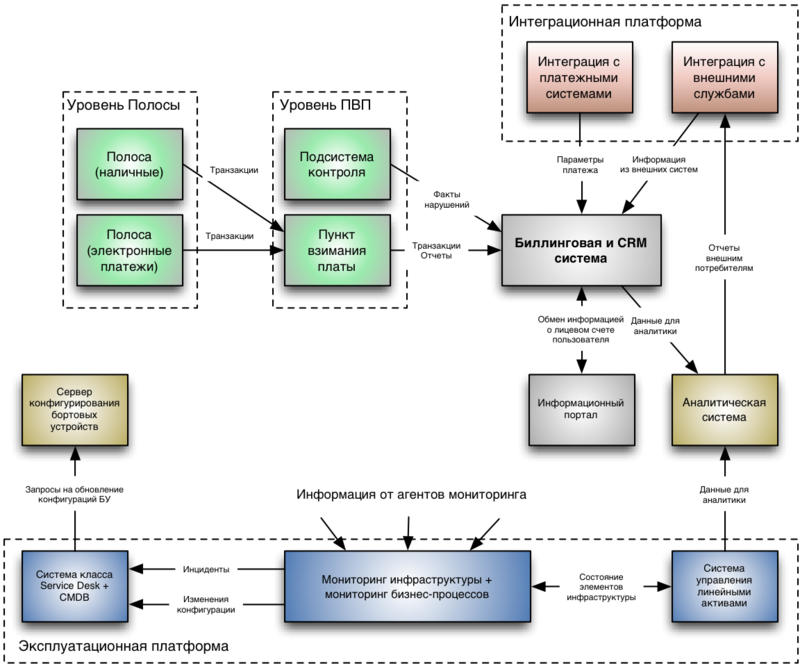Toll road architecture

So, colleagues, continue the road theme. The Mkhatovskaya pause has been delayed since my last publication until the obscene, but there is still no similar articles. People's memory is weak, and I have already begun to send links to my own posts. In order to satisfy the hunger for information, I would venture to talk about toll roads.
In these theirs of Europe there are a lot of toll roads, as it is very difficult to maintain a decent quality highway for public money. But the question is not even in content, but in construction. Such a break through the money to the state from nowhere to take. We have to call the capitalist for help and create a concession with him. The state and the capitalist build a road together, then a private investor exploits the road for a while and collects tribute from motorists. And after the time stipulated in the concession agreement, it passes the road to the state.
')
In our country, like mushrooms, separate pieces and fragments of toll roads began to appear after the rain. The state plans total construction of thousands of kilometers of toll roads, on which ordinary Russians' cars rush right into a bright future ... People wishing to invest in such a profitable enterprise come up from all sides and offer each other their “high-tech” solutions. Which, in general, I would like to dedicate the rest of this text.

Who is last? San Francisco-Oakland Bay Bridge interchange, opened in 1936
Toll roads are open and closed types. The simplest is open. You pay a bribe to cross a charging point (UIP) . Such options put us on the constructed in haste transport rounds. Such PVP can even not be connected to a LAN, since they collect money independently and independently from each other. Reference changes can be brought there on a flash drive.
The second variant of execution is closed roads according to the type of paid parking. At the entrance you take a ticket, at the exit you pay money for the mileage traveled. Accordingly, all entrances to such a road must be specially equipped, and at the congresses there must be a PVP, which greatly complicates the design and requires the laying of communication channels along the road connecting the infrastructure elements. Serious highways make such as the planned Moscow-Peter highway, which is already scandalously famous, the Moscow-Nizhny Novgorod highway that exists strictly on paper, and the road along which the hajj takes place every year towards the Sea — the Don highway (not detours, but planned for the construction of this year long segments).

PVP on the M4 "Don"
From the point of view of the system architecture, the whole complex can be divided into three levels. The first level is called the strip level and consists of a bribe taker, barriers, traffic lights and attachments. The task at this level is simple - to take money and collect an evidence base in the event of future clashes.
The scheme works as follows. At the entrance to the PVP, the laser range finder detects the fact that the victim is approaching and sends a signal to the PVP systems to become alert. The driver according to the inscriptions on the PVP peak selects the band on which his means of payment is supported: cash, contactless cards or means of payment via shortwave radio communication (transponder). Then at the entrance to the strip there is a photo and video of the car, its license plate and the driver’s tricks for the personal collection of the operator. Auto scanner measures the dimensions of the car. Modern scanners allow you to build a three-dimensional model of the car (in the form of a frame parallelepiped). Measurement is required for vehicle classification and tariff calculation. In Europe, classification according to 6 classes is adopted - from a motorcycle to a truck with a trailer. Laser 3D scanners support up to 20 classes configured in the software settings. In fact, we ourselves can program the classification rules based on measurements of the width and length of the car. It is legally important to determine the allowed vehicle mass and the number of axles used. There are tables for calculating the damage caused to the road by various heavy trucks, so it is logical to take more money from them. Some PVPs are also equipped with WIM (Weight In Motion) non-stop weight control systems, which provide fairly reliable results on axle weight distribution even at a speed of 30 km / h.
After measurements and photo shoots, the car drives up to the booth (in the case of cash payment or a contactless card) or passes the PVP without stopping (in the case of using a transponder). In the first case, the barrier is opened after payment and the car continues on its way. Finally, an additional photo and video is taken of how the car leaves the PVP. This is necessary so that cunning operators do not underestimate the class of the vehicle for rolling back. Well, it should be, in general. All information collected in the process of driving the VFR (as well as the time of entry into the toll road of a closed type) is interconnected and is called a transaction.
A special subsystem on the strip ensures that the transaction is correct. Europe, for example, suffers from brisk motorcyclists who strive to slip by two or three. Automation can make a mistake in determining the license plate, in determining the size and much more in what. Therefore, a specially trained person is assigned to the machine, whose responsibility is to correct the mistakes of a stupid machine. Over this person there is another person who is watching that the first one does not cheat. And above both of them - a central computer with statistics for the drive over the past five hundred years, connected to the traffic police bases.

Typical layout of equipment on PVP strips, copy-paste from the American manual
The second level is the level of the point of collection (also known under the beautiful name Toll Plaza). The bosses of bribe-takers are sitting there, and there is also a warm toilet and some computer equipment. At this level, information is collected from all PVP bands, equipment operation is monitored, and the collected cache is packed in bags. On some PVP, special pneumatic mail is used to transfer cash from the lanes to Toll Plaza. There are PVP options with underground corridors through which PVP operators can walk from booths to the office and back.
The third level is called the Central Level or Section Level (for especially complex multi-tier collection schemes). This level collects information about transactions from all controlled PvP, works with banks and manages user accounts. The principles of operation of the central toll collection system strongly resemble the principles of communication providers. The service of passing through the highway is similar to the data transfer service, billing and billing are also identical in essence.
The options for working with user accounts depend only on the imagination and size of the concessionaire’s wallet. Accounts can be commercial and non-profit, prepaid and postpaid, profitable and unprofitable. A portal with a user's personal account can be bolted to the side, where they will be offered a hundred and one way to deposit their money.
Similarities with carriers adds the use of transponders. A transponder is a small box that is attached to the windshield of a car and is able to exchange information with PVP equipment over a shortwave connection. Information typically includes a transponder ID, information about the car and driver. Sometimes the transponder is able to count the balance of money on a prepaid account and notify the driver of the approaching zero. There are transponders with GPS / GLONASS support and even with updated road graphs, but these are already elements of a slightly different system, which I will discuss later.

Sketch of the functional architecture of the charging system
It is not difficult to assume that each concessionaire wants to use his unique transponder box, his prepaid cards and in general all his own. European countries are currently dealing with dozens of road operators that are poorly compatible with each other. The resulting chaos is trying to streamline from the very moment of its formation - system integrators of all levels of work have always had enough. But recently, the bureaucratic colossus of the European Union has turned the main gauges in the direction of the total introduction of standardization on the roads. They are currently inventing a mega-transponder that will allow them to cross Europe without a collection of gadgets on the windshield. Well, the flag, as they say, in their hands.

As for Russia, then chaos is just beginning. We do not yet have centralized fee-raising operators, but PVPs are fundamentally incompatible with each other in the fields. With such a chic backlog, our integrators create a stable feed base for the years ahead. It is important to understand the specifics of road automation and not to require too much from the road people.
The success of the automated solution for roads is based on an integrated approach that can solve the problems not only of building systems, but also of their further operation. And these are classic IT services, and work with road assets - road maintenance, infrastructure repair, and so on. The integrator that will separate one from the other is most likely to be removed from this business. So, colleagues, learn materiel and be attentive while driving.
Source: https://habr.com/ru/post/137737/
All Articles